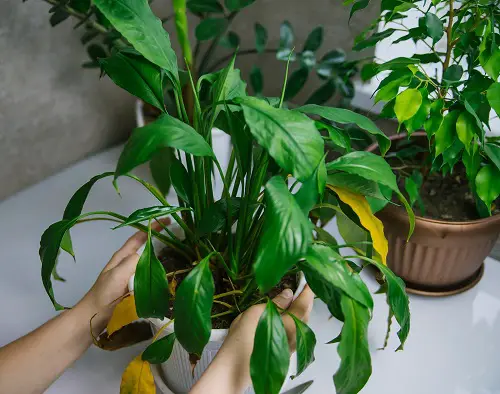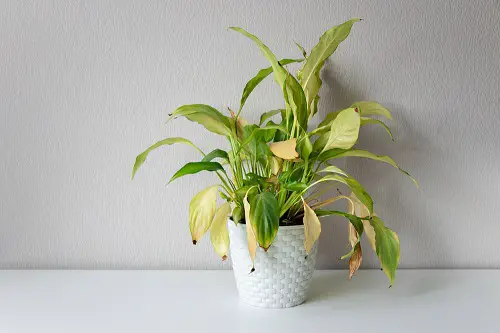Wondering Why is My Peace Lily Drooping, Turning Yellow, Not Flowering & Dying? Read about the reasons and solutions below.

Peace Lily is a beautiful indoor specimen with lush, glossy leaves and a modified bract that emerges hooded on the tiny white flower spike. But, are you wondering, Why is My Peace Lily Drooping, Turning Yellow, Not Flowering & Dying? Here are all the reasons and solutions to help you out!
Learn about Propagating Peace Lilies here
Why is My Peace Lily Drooping, Turning Yellow, Not Flowering & Dying?
1. Natural Aging
As a part of the natural phenomenon, Peace Lilies foliage tends to turn yellowish or brown after the plant has run its course. On average, Peace Lilies survive three to five years under suitable growing conditions. You may then find the leaves drooping, fading, turning yellow, and finally wilting away.
How to Fix: There’s no solution to revive an aging plant. However, you should snip the dried leaves with sanitized tools to keep the plant tidy.
Find out the Most Common Problems and Solutions to Growing Peace Lilies here
2. Inappropriate Light Exposure
Native to the tropical rainforests, Peace lily appreciates bright filtered sunlight. If the plant is exposed to the scorching afternoon sun, the leaves will burn with brown tips and a pale yellow hue.
However, insufficient sunlight will stress the plant, inhibiting its ability to photosynthesize.
How to Fix: Move the plant to an area with 6-8 hours of bright indirect sunlight. The house’s North or East facing corners are the perfect fit for Peace Lilies.
3. Lack of Nutrients
Lack of nitrogen often leads to fading leaves in Peace Lilies, while the absence of iron or magnesium results in yellow foliage with green veins.
Remember not to over-fertilize the plant, which might turn the tips brown with little to no flower production.
How to Fix: Fertilize the plant with a balanced 20-20-20 blend, diluted to half its strength every 6-8 weeks. If the plant is in a root-bound stage, consider repotting it in a fresh growing medium.
4. Low Humidity
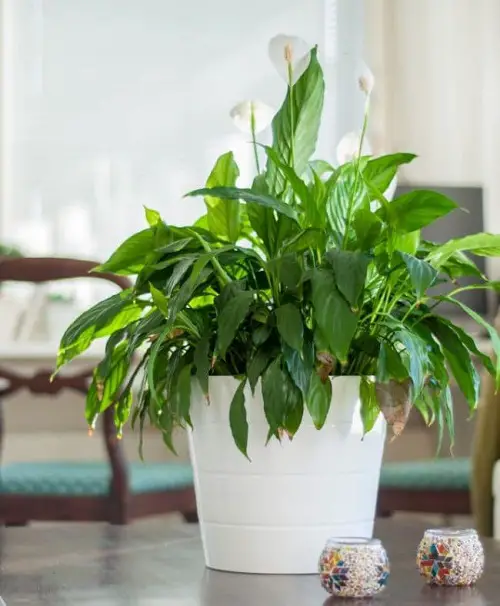
If your peace lily has brown and crisp leaf tips, it is due to low humid conditions. This is common in homes where heating vents are used. The plant needs 60-70 % humidity to produce lush, glossy foliage.
How to Fix: To mimic the native atmosphere, raise the humidity by grouping plants together or place the Peace Lily on a tray filled with pebbles and water. You may also mist the foliage or use a humidifier.
Want to Get Your Peace Lilies to Bloom? Click here
5. Transplant Shock
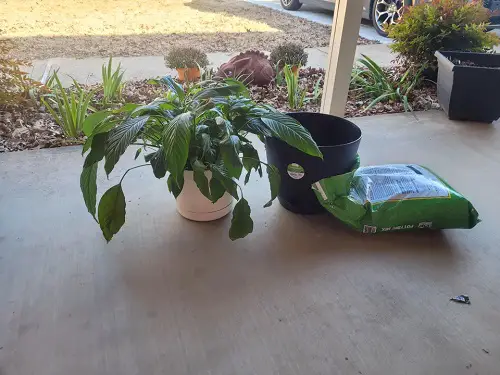
If you notice fading or yellow foliage right after moving the plant to a new pot, it signifies transplant shock. However, Peace Lilies have a pretty healthy root system and recover from the shock as soon as protective measures are initiated.
How to Fix: Continue to water, and do not expose the plant to extreme light. Do not feed or trim off any dead leaves. Keep the wilted ones on the plant until it recovers to avoid more stress.
6. Over or Under Watering
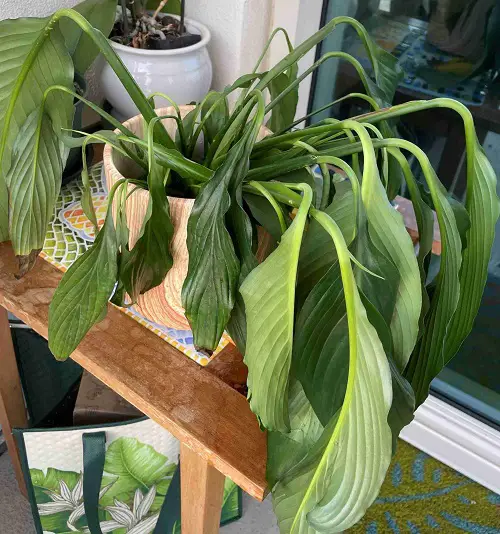
Yellowing of leaves is a common phenomenon for both over and under-watered plants. If you notice extensive yellow foliage, brown leaf spots, and droopy stems, you need to cut down on watering.
While faded or dried-out leaves, droopy foliage, and brown tips are a sign of underwatering. In both cases, immediate action is required to sustain the plant growth.
How to Fix: Water the plant when the topsoil feels dry to the touch. Grow Peace Lily in a container with ample drainage holes. For an overwatered plant, take it out from the pot, cut off the damaged roots, and re-pot it using a fresh potting mix that is not moist.
7. Water Quality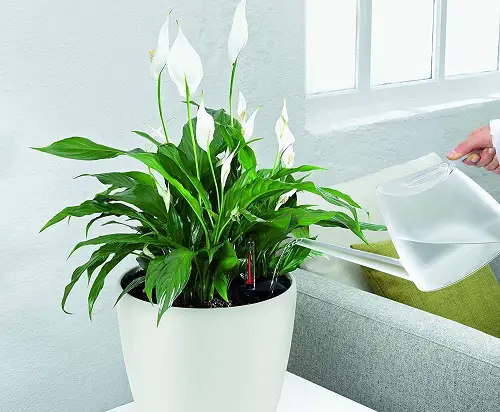
Tap water is often loaded with chlorine, fluoride, and other salts, which builds up and negatively affects the health of your Peace Lily. Sensitive to excess salt or chlorine, the foliage turns yellow and wilts away.
How to Fix: Always use filtered RO water. If you use tap water, let it sit overnight to settle the minerals.
8. Temperature Fluctuations
Changes in temperature or extreme fluctuations stress the plant, leading to the yellowing of leaves. The plant appreciates an indoor temperature of 65-85 F or 18-29 C. Anything above or below this range is not suitable for the healthy growth of your Peace Lily.
How to Fix: Keep the plant away from heating or cooling vents. Try to mimic a constant room temperature around the plant. Do not expose the plant to frost or scorching heat.
9. Pests and Diseases

Sap-sucking pests such as aphids and mealy bugs stress the plant, resulting in wilted, yellow foliage or brown tips, spots, and margins. Spider mites and thrips also affect the growth of the plant.
How to Fix: Wipe the leaves with cotton dabbed in neem oil or insecticidal soap to eliminate pest problems. Avoid overwatering to keep fungal diseases away.


